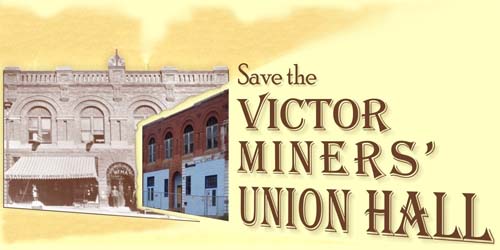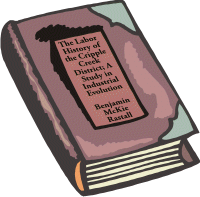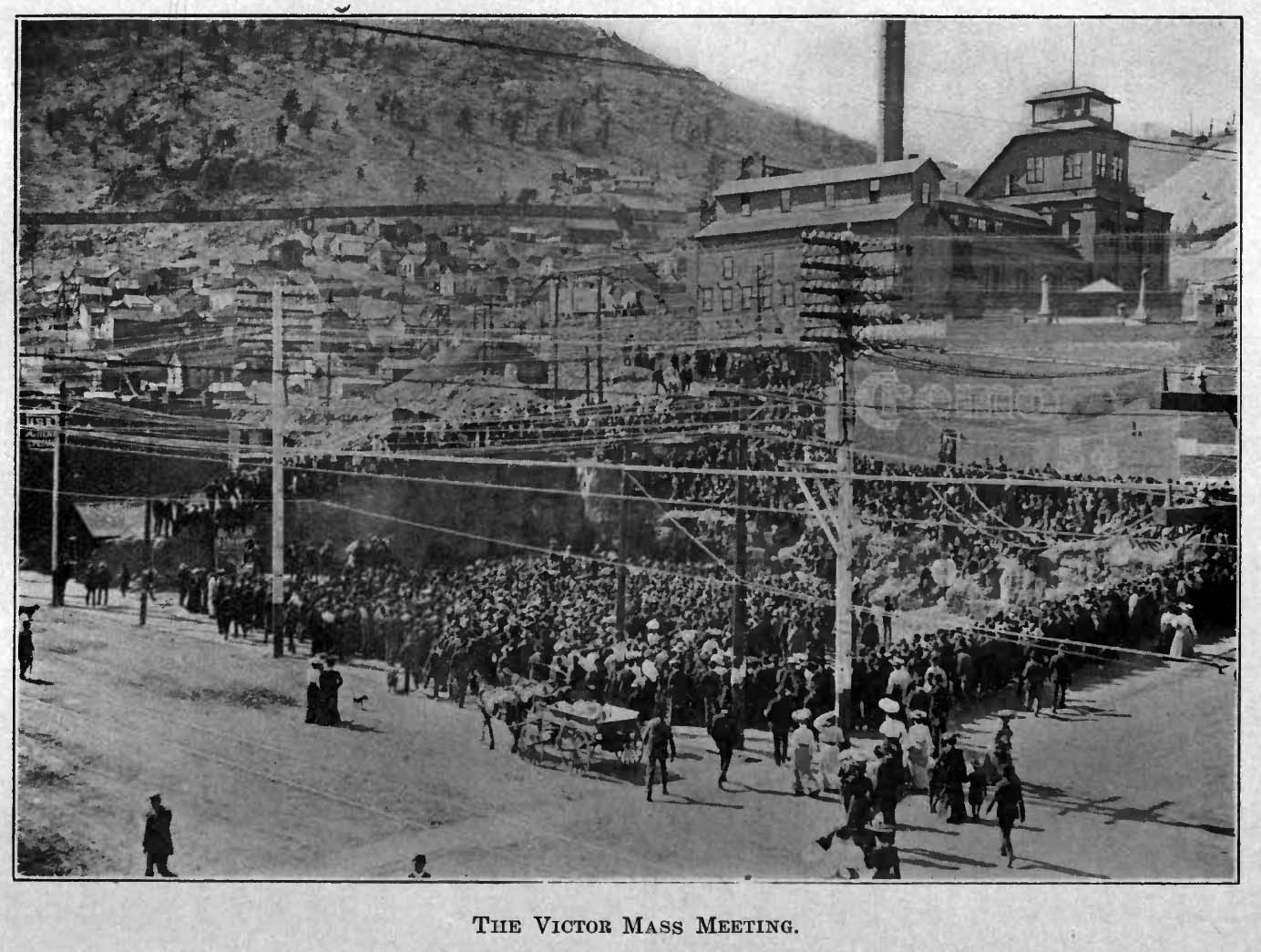 |
Victor
|
The Labor History of the Cripple Creek District;
A Study in Industrial Evolution
by Benjamin McKie Rastall

pages 134-138
Period Immediately Following The Strike
Although the miners unions of the Cripple Creek District were entirely broken up, the Western Federation declared the strike still in progress, and in fact has never officially withdrawn it. Partisan feeling continued to run strong for a considerable time, and showed itself for months after the withdrawal of the militia. Five men, J. C. Frazier, David O'Neill, William Hovey, C. M. Tully, and Fred Warburton, who had been deported but returned to the district, were run out of Victor by 25 masked men. At some distance from the city they were robbed of all their valuables, including passes that had been issued to some of them by the militia. They were then flogged; one of them knocked down with a rifle and kicked, and then sent on, threatened with hanging if they should ever return. Eleven Italians, who came into the district in a body on the F. & C. C. R. R., were escorted out by a body of citizens. W. J. Donnely, a former mayor of Victor, went on the bond of one of the arrested miners, and was threatened and warned to leave the district.29 T. H. Parfet, and John Harper, managers of the union stores at Cripple Creek and Victor, returned to settle up the affairs of the wrecked concerns. Harper was taken from his home by a number of masked men, beaten, and driven from the district. Parfet met the same experience later, being so badly beaten that he could not walk. The home of George Seitz, a former union man who was leasing and had not taken out an association card, was entered in the middle of the night, and several shots exchanged, Seitz standing his ground and driving the men out. A. L. Leduc, while returning home from taking supper with a neighbor, was waylaid, robbed, beaten with the handles of whips, and run out on the road to Canon City. G. R. Hooten, who had been manager of the Federation store at Anaconda, was taken from his home, beaten with guns and cartridge belts, robbed of his purse and gold watch, and put on the road to Canon City.30
THE VICTOR MASS MEETING
The union stores at Victor and Cripple Creek were turned over to the Interstate Mercantile Company, about the middle of August, and the Cripple Creek store reopened. The new company was supposed to have purchased the property from the unions, but people generally believed that this Was simply a disguise and that the stores were really still owned by the Federation.31 On the afternoon of August 20th at about 4:30 a mob of several hundred men suddenly formed on the main avenue of Cripple Creek. The store of the Interstate Company was broken into, and its manager and clerks thrown out without being allowed to even close the safe or take the account books. The windows and fixtures were smashed, and the goods mixed and thrown into the street, where a large part of them were destroyed or carried away. Deputy District Attorney Butler, hearing of what was taking place, came to the scene, and going to leading men whom he found there asked them to order the mob to disperse, but was simply laughed at. Persisting in his efforts he was seized by three armed men, forced from the scene and detained for some time. The sheriff's office, located almost directly across the street from the store, made no effort to protect it, or to disperse the mob.32 The same evening a number of men were deported. The list is as follows:
J. C. Cole, formerly deputy district attorney.
Michael J. O'Neil, deputy county clerk and recorder.
Frank J. Hangs, attorney for the Western Federation of Miners.
H. M. Heimerdinger, manager of Interstate Company's store.
Frank Akins, local manager in said store.
Charles H. Wasson, clerk in said store.
Steve Leahy, clerk in said store.
J. W. Higgins, union man.
T. H. Parfet, union man.
Albert L. Pierce, Gus Girardo, James Redd, Patrick Maloney.
Eugene Engley, attorney, sympathizer with Federation.
The men were driven from town in buggies, and finally placed on foot on the Canon City road. Some of them were beaten and robbed, and shots were fired over their heads as they started off. All were threatened with violence should they dare to return.
Deputy District Attorney Butler, having secured affidavits from some of the deported men, prepared informations against those who appeared to have been the leaders in the wrecking and deporting.33 The eases came to trial in the spring of 1905, but while they were before the court, C. C. Hamlin, the secretary of the Mine Owners' Association, who had in the meantime been elected district attorney, dismissed them all.34
The general result of the conflict, and more particularly the effect of the deportation and scattering of the union men, was shown most strikingly at the November, 1904, elections. For the first time in the history of the county the Republican party triumphed at the polls, electing its entire ticket.35 Edward Bell, having left the Democratic standard, was elected sheriff; C. C. Hamlin, secretary of the Mine Owners' Association, was elected district attorney; and the other vacant offices were filled largely with prominent Citizens' Alliance men.36 The officers of the local militia companies who had been most active in the later phases of the strike were also remembered, a number of them stepping into county or municipal offices.37
The Colorado City and Cripple Creek strikes covered a period of a year and a half, and from the call of the second strike at Cripple Creek until the final withdrawal of the militia, a year, lacking a very few days, had elapsed. The state troops had been in the field for a period of nine months. Thirty-three men had met violent deaths, and many more been injured by crimes and accidents traceable directly to the strike. Some idea of the intensity and meaning of the struggle can be gained by noting the enormous losses involved. The militia campaigns in the Cripple Creek District cost the state of Colorado $400,000, the pay rolls alone amounting to nearly $200,000.38 The "relief" expenditures of the Western Federation of Miners for the fourteen months beginning August 1st, 1903, were $308,000, almost the entire sum being expended in connection with the Cripple Creek strike.39 If to these amounts be added the losses to the men in pay rolls; the losses to the militiamen in the small wages received; the losses to the mine owners in attempting to operate with unskilled labor; and the losses to business paralyzed throughout the county, the sum total becomes enormous. This represents, however, only one small phase of the matter, an external index of the importance, the desperation, and the terrible mental and physical wastes of the whole contest. From the struggle that so convulsed it the Cripple Creek District has not yet recovered, and will not entirely for many years to come. To many the strike meant ruin, to others premature age. Hardly a citizen of the whole area but has had to carry some share of the load, and in losses and taxation, the burden will continue to bear heavily upon the entire state.
29Deputy District Attorney Butler went to Mr. Donnely. and asked him in the interests of general law and order to make affidavit to the facts so that an example could be made of the case, and such violations of the law thus prevented in the future, but this Mr. Donnely was afraid to do.
30The case of Jack Burke may be taken as showing the extreme attitude of the associations at this time, and the partisan position of many of the county officers. Burke was a Cripple Creek business man, a property holder, and according to all the testimony in the case a good citizen. He was, however, strongly in sympathy with the miners unions, and found it wise to leave the district. Upon his return in October a criminal complaint was sworn to by Sheriff Bell charging him with vagrancy. Deputy District Attorney Butler dismissed the case, closing as follows: "I have known this man for years. I know him to be a reputable, law abiding citizen of Teller County. I have gone into this matter deeply, and I find that there is not the slightest excuse for this unwarranted arrest. For that reason I ask the court to order his dismissal." Mr. Butler also took occasion to declare publicly that in his office he recognized no class distinctions, and should look simply at the question: "Did the man violate the laws or not?" Thus was nipped in the bud what there was every evidence to believe was a plan to arrest as a vagrant every deported miner who dared to return.
31This was doubtless correct, see Official Proceedings W. F. M. A., 1905, p. 43.
32Special Report of United States Commissioner of Labor, p. 310 Sheriff Bell was in Denver and the office was in charge of Undersheriff Parsons.
In an interview next day Governor Peabody said: "I have not been officially notified of the occurrences of yesterday. No call for aid from either faction has reached me, nor have I received any Intimation that the State's assistance is needed in the settlement of the local differences which exist there now. I therefore infer that the local authorities feel confident of their ability to control the situation."
33The following men were made defendants :
Nelson Franklin, former mayor of Victor, mill owner.
A. E. Carlton, president First National Bank, mine owner.
E. C. Newcomb, cashier same bank, mine owner.
William Carruthers, solicitor for D. & S. W. Ry.
Harry Waters, Frank Vanneck, E. K. Young; deputy sheriffs.
Charles Gunn, policeman.
A. C. Cole, former secretary Victor Citizens Alliance.
Henry Dahl, manager Ophir mine.
Dan'l McCarthy, superintendent Granite mine.
A. T. Holman, superintendent Golden Cycle mine.
William Bambridge, superintendent El Paso mine.
L. G. Henry, R. P. Russel, John Sharpe; leasers.
Harvey Gregory, H. H. Babcock, Ira Watson, Woody Welsh, C. R. Orwig, Thomas Scanlon, Albert Stonehouse, Blum, Johnson, Pierce; miners and deputy sheriffs.
John Dalzell, mine superintendent
34The district attorney has this absolute power under the Colorado laws.
35There were one or two unimportant exceptions.
36Following are the prominent Citizens' Alliance men and officers of the military companies elected or appointed to county offices:
Sheriff, Edward Bell, prominent Alliance man.
Undersheriff, D. F. Parsons, secretary Citizens' Alliance.
District Attorney, C. C. Hamlin, attorney for Mine Owners Association.
County Attorney, T. E. McClelland, major state militia.
Deputy County Clerk, G. S. Hoag, captain state militia.
County Treasurer, S. A. Phlpps, president Citizens' Alliance.
County Physician, W. E. Driscoll, prominent Alliance man.
Jailer County Jail, Harley Keegan, first lieutenant state militia.
Deputy County Assessor, Frank Trego, captain state militia.
The officials of the towns and cities show the same kind of grouping.
37At the election James Warlord, formerly a deputy in the employ of the Mine Owners' Association, shot and killed two men at one of the polls. The evidence at his trial was strongly to show that the murder was cold blooded and entirely unprovoked. The jury disagreed. Judge Cunningham refused to admit ffarford to bail while awaiting a second trial. District Attorney Hamlin then dismissed the case, alleging the impossibility of securing a conviction, and the great expense. A second information was later filed.
38Reports of the State Auditor and Adjutant General for 1003-4.
39Reports of Treasurer Haywood in Official Proceedings W. F. M. A. 1904 and 1905.
NEXT: History of the federation — Its socialistic tendencies — Sympathetic statement of its position
